

 The South African
The South African
* Counsellor at the South African Embassy in The Hague, the Netherlands.
The morning of 8 February 2020 broke cold but clear over the Wings of Liberation Museum outside the town of Best in the South Brabant province of the Netherlands. A crowd of about sixty people, a number in the military uniforms of Commonwealth States and the Netherlands, gathered in front of the museum for the unveiling of a memorial in honour of the fifteen crew members of two Avro Lancaster III bombers who died when the planes, return-ing from a bombing run over Germany, collided and crashed nearby, exactly seventy-five years before.
The pilot of one of the Lancasters, ND 961 of 97 Squadron, RAF Lt Charles William McGregor (force number 31794V), was a South African who was seconded from the(SAAF) South African Air Force to the Royal Air (RAF). The only survivor was the pilot of the other Lancaster, PB-181 of 83 Squadron RAF, F/Lt E.P. Weber.
While F/Lt Weber and his crew were RAF members, Lt McGregor's crew was a more mixed bunch; besides himself being from South Africa, the bomb aimer F/Lt R.C. Smalley was seconded from the Royal Canadian Air Force, the wireless operator F/Lt R.H. Cheatle was from the Royal Australian Air Force while the rest of the crew was British: the Flight Engineer Sgt. J. Shield, the navigator F/O A.J. Norton, visual air bomber F/Lt G.S. Johnson (DFC with Bar), and air gunners Sgt. D.S. Lennie and F/Sgt. P.G. Cannon.
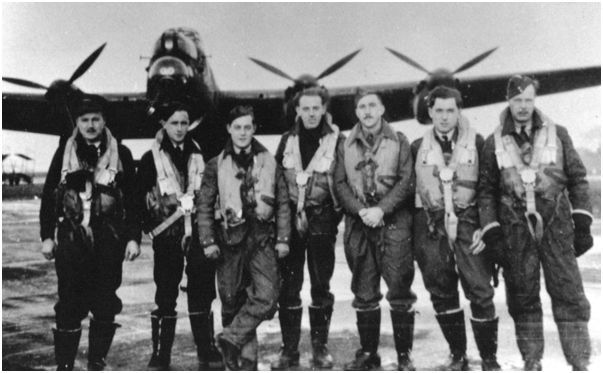
The crew of ND 961: F/Lt Johnson, F/Lt Cheatle, Sgt Lennie,
Sgt Shield, Lt McGregor, F/O Norton, Sgt Cannon
Besides F/Lt Smalley, who is buried in the Canadian War Cemetery near the town of Groesbeek, the crew members of ND 961 were buried in the Woensel General Cemetery, near the town of Eindhoven.
The two Lancasters were part of a fleet of 177 Lancasters and 10 Mosquitoes from Bomber Group 5. The aim of the operation was to destroy the aqueducts where the Dortmund-Ems canal crosses the Muhlenbach River, an important transport route for the German war industry, at Ladbergen. Ladbergen is a town northeast of Munster and was an important target area because of the junction of waterways there, used by the German army for the supply of raw materials for the war industry and the transportation of war equipment. The Dortmund-Ems Canal is a 269km long canal, completed in 1899, running between the inland port of the city of Dortmund and the seaport of Emden. It was therefore of great strategic importance as an industrial transport route providing an outlet from the highly industrialized Ruhr area.
RAF Bomber Command therefore launched several attacks on the canal, starting in 1940, with a view to permanently disabling it from sustaining the German war effort. On the night of 15/16 September 1943, 617 Squadron, the famous Dambusters, lost five of eight Lancasters employed in an attack on the canal in ‘Operation Garlic’. Between 1944 and 1945 Bomber Command launched four more attacks.
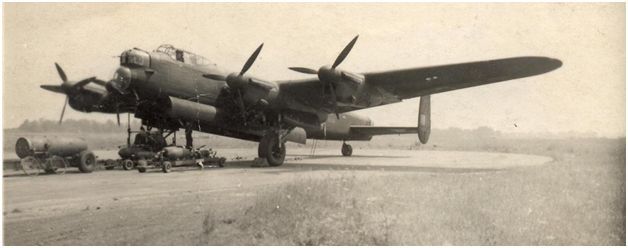
A Lancaster being readied for a sortie
The flight path of the Lancasters on the night of 7 February 1945 followed the southern route and crossed over the territory of the Netherlands which had been liberated by that time, in order to, as far as possible, avoid anti-aircraft fire and enemy fighters.
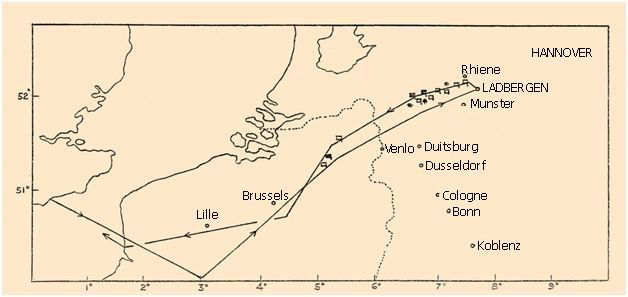
The flight path for the ill-fated mission
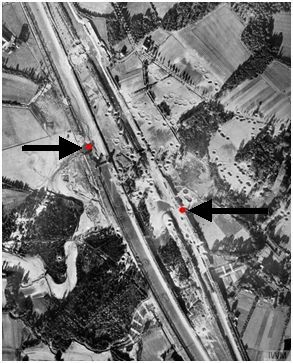
Target points marked by the red dots and black arrows.
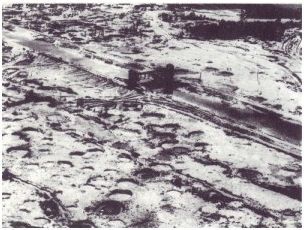
Note the large number of bomb craters in the target area
The point of attack was at a place called Greven, near Ladbergen, where the canal divided into two branches, the target point being the two white arrows shown on the photo, the aqueducts where the canal crosses the river. This small target was difficult to hit accurately, as is clear from the large number of bomb craters off the target.
However, this fifth raid was not a success (1). Bomber History website reports as follows:
The fifth attack around midnight on February 7, 1945 was not a success. The air defences on site proved to be considerably strengthened and could prevent this fleet of 177 Lancasters from concentrating the attack on the actual goal. As a result, the fleet became scattered and many of the bombs with delayed ignition ended up in an open field. The target channel remained virtually undamaged.
Descriptions of the raid range from "quiet trip" to "disorganised gang". The accompanying Pathfinder aircraft group, which flew along as an escort and to mark the target, reported: "It was by no means a success, but hopefully we have caused some damage to the enemy."
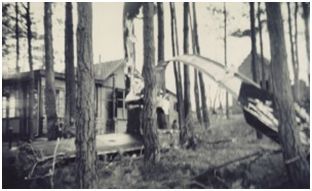
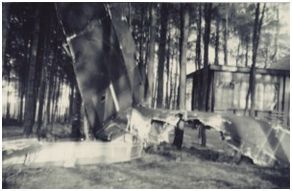
Above and right - Wreckage of ND 961
In the forest near Son
During Operation Garlic 617 Squadron used the so-called "Tallboy" super bomb. Designed by Professor Barnes Wallis who was also responsible for the Dambuster bouncing bomb, its sleek design aimed at driving it deep into the ground before exploding, creating an earthquake effect (2).
Both Lancasters involved in the collision were from squadrons allocated to the Pathfinder Force. Pathfinder aircraft were tasked to, during night bombing raids, locate and mark the intended target with flares in advance of the arrival of the main force in order to improve accuracy (3).
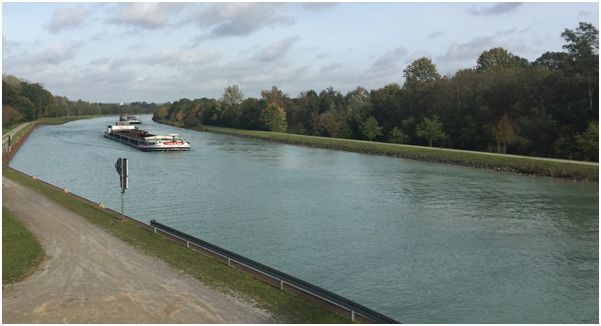
The Dortmund-Ems Canal today
It is also recorded that communications between the aircraft and the base of departure, RAF Coningsby in Lincolnshire, broke down immediately after take-off. Five of the Lancasters did not return, including ND 961 and PB 181.
The collision between the two Lancasters took place at about 00:40 on the morning of 8 February 1945 under conditions of bad weather and limited visibility. It appears that ND 961 was slightly higher than PB 181 when they collided, and that the impact had sheared off the cockpit roof of PB 181, catapulting the pilot, F/Lt Weber, out of the aircraft(4). He passed out but regained consciousness some minutes later, allowing him to open his parachute, landing safely four miles northwest of Eindhoven. As wreckage was scattered over a large area, it appears that the planes had broken up in the air, most of the wreckage of PB181 coming down close to Best, and ND-961 in the neighbouring town of Son.

Laying of South African wreath
The memorial was unveiled in a moving ceremony by the mayors of the towns of Best and Son, and relatives of some of the crew members who could be traced. The memorial was erected as a private initiative by of group of local enthusiasts and local sponsors covered costs. It consists of a propeller of a crashed Lancaster on a foundation of bricks, and a plaque on which the background of the incident is recorded, and the names of the fallen are recalled. From the monument there is a view of the forest in which the two planes came down.
2020 also marks the 75th year of the liberation of the Netherlands from German occupation, and to keep the memory alive, it was therefore appropriate that the youth was involved, members of the Scouts lighting a candle for each of the deceased.
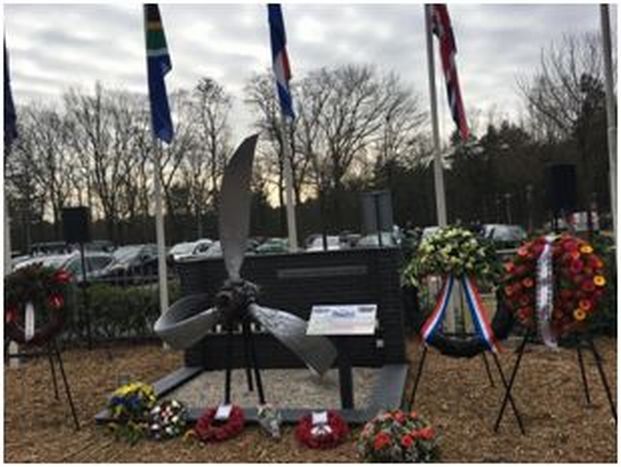
The memorial to the crews of the two
Lancasters after the unveiling ceremony
Representatives of the armed forces of the United Kingdom, Canada, Australia, the Netherlands and South Africa were in attendance and laid wreaths. The wreath laid on behalf of the South African Government and people was placed by Lt Col Andrew Mafofololo, acting Defence Adviser to the South African Embassy in Brussels, and Mr Andre Stemmet of the South African Embassy in The Hague.
For the South Africans present at the ceremony, it was intensely moving to experience the dedication of the Dutch volunteers who erected the monument, and of the local communities to honour the young lives lost in the battle for freedom in Europe. It was especially poignant that the memorial was unveiled 75 years to the day after the tragic loss of fifteen young lives.
Lt. McGregor
Charles William McGregor was born in Cape Town on 12 April 1919 to Charles and Janet Margaret McGregor. After spending some time in Bloemfontein, the family moved to Johannesburg, where Charles attended King Edward VII School. According to his death notice that appeared in a Johannesburg newspaper, he excelled in rugby, playing for the school's first XV. He also participated in hockey and swimming, and his hobbies are recorded as "reading." After matriculation in 1937, he joined the Premier mine, quickly rising to the position of shift boss. King Edward School had a long relationship with the Transvaal Scottish Regiment, which had since 1906 instructed the School Cadet Detachment. It was officially allied to the Transvaal Scottish in 1920, this relationship explaining McGregor's decision to join the 1st Battalion, Transvaal Scottish on 20 February 1940, with the rank of Lance Corporal (5)
Together with his unit, he embarked on 16 July 1940 in Durban on the Delaware, disembarking at Mombasa in Kenya on 24 July 1940.
It is interesting to note that he was a participant in the raid on the Italian outpost at El Wak in Somaliland on 16 December 1940, which, according to war historians, must be classified as the first Allied victory of the Second World War (after a long series of defeats at Dunkirk, Greece, Crete, and elsewhere).
McGregor was a member of the battalion machine-gun platoon. According to his medical record on his personal file at the Defence Force Archives in Centurion, he was hospitalised on 4 February 1941 in a field hospital of the 10th South African Field Ambulance, and discharged on 25 February 1941, rejoining his unit. It appears that he was injured when the tripod of a Vickers gun fell on his left foot.
This meant that he missed out on the breakthrough crossing the Juba River in what was then known as Somaliland. However, he was soon back in action for the epic 17-day dash along the Italian Strada Imperiale from Mogadishu to J.iga in the Somali part of Ethiopia, and eventually the fall of Addis Ababa to the Allies.
McGregor's brigade was then rerouted to the Middle East, disembarking at Suez on 27 June 1941. He was promoted to Corporal on 28 July 1941, with full pay and allowance. Despite this promotion, he was clearly not intending to spend the rest of his military career in khaki, as he applied to join the SAAF. On 2 October 1941 he left Suez on the SS Strathaird, disembarking in Durban on 16 December 1941, hopefully getting the opportunity to spend Christmas with his family in Johannesburg. He was posted to No 2 Air School in Randfontein, for elementary flying training on the Tiger Moth DH82A, proceeding to No. 21 Air School in Kimberley for advanced training on the Airspeed Oxford. Both Air Schools were part of the Commonwealth Joint Air Training Scheme facilities in South Africa. On 27 April 1943 he signed the General Service Oath, thereby indicating a willingness to serve outside the African theatre and was commissioned as 2nd Lieutenant on 26 June 1943, the day he received his wings.
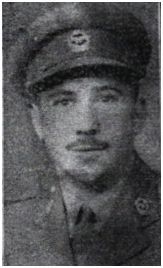
Lt McGregor in SAAF uniform
On 21 August 1943, he was posted for service with the Royal Air Force and embarked for the United Kingdom from Cape Town harbour on 31 August 1943, and after a journey of more than two months at sea on the Rangitata, which included a visit to Montevideo in Uruguay, disembarked on 7 November 1943.
His service with RAF included several further training courses. After initial training with 29 Operational Training Unit, he was posted to RAF North Luffenham, where night bomber crews were trained on the Vickers Wellington. He was then posted for flying duties on 27 October 1944 to 106 Squadron, which operated Lancasters at the time, and then on 22 February 1944 to 97 Squadron.

Lt McGregor's grave in
Woensel General Cemetery
At the time of Lt McGregor's death, his father was already deceased. In 1948 his widowed mother wrote to the War Records Office in Pretoria, with a request to receive his log book, war medals and any photographs of her son. This resulted in a correspondence between the War Records Office and the Air Ministry in London. Mrs McGregor was informed that Lt McGregor was eligible to receive the 1939/1945 Star, the Africa Star, the France and Germany Star, the Defence Medal, the 1939/1945 War Medal and the Africa Service Medal, the logbook being forwarded by registered post to the War Records Office from the RAF Central Depository on 10 April 1948.
Adriaan van Zantvoort is from Eindhoven, and has been researching Bomber Command air crashes in the southeast of the Netherlands for over twenty years. In 1999 he established contact with Lt McGregor's youngest sister, Norma. Some years later Norma visited the Netherlands, and Adriaan took her to the crash site, and also showed her his personal Second World War collection.
Due to Adriaan's efforts a presentation on Lt McGregor was done some years ago in the museum.
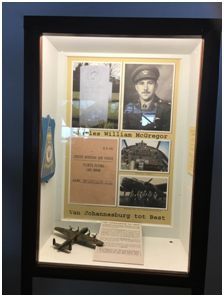
Presentation in the
Wings of Liberation Museum
SOURCES AND REFERENCES
Efforts by Adriaan to locate relatives of Lt McGregor have not been successful. It is known that Norma has passed on some years ago. Lt McGregor had two other sisters, Sheila, who was married to Reginald Rowland Mitchell Cousens, and Marge, who was married to a Dutchman, Zeeger Denik. It is known that Marge's grandson is living in the United Kingdom.
Any information on relatives of Lt Mc- Gregor would be highly appreciated by the authors, who are trying to trace them.
Return to Journal Index OR Society's Home page
South African Military History Society / scribe@samilitaryhistory.org